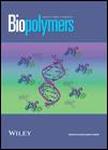版权所有:内蒙古大学图书馆 技术提供:维普资讯• 智图
内蒙古自治区呼和浩特市赛罕区大学西街235号 邮编: 010021

作者机构:Norwegian Radium Hosp Dept Tumor Biol N-0310 Oslo Norway PubGene AS N-0319 Oslo Norway
出 版 物:《BIOPOLYMERS》 (生物聚合物)
年 卷 期:2003年第70卷第3期
页 面:364-376页
核心收录:
学科分类:0710[理学-生物学] 081704[工学-应用化学] 07[理学] 08[工学] 0817[工学-化学工程与技术] 070303[理学-有机化学] 0703[理学-化学]
主 题:DNA melting hybridization helix-coil transition Poland-Scheraga nearest neighbor thermodynamic parameters format end interactions algorithmic complexity loop entropy factor genomic sequences partition function numerical overflow matrix multiplication recursion base-pairing probability loop probability domains
摘 要:We describe an optimized algorithm, which is faster and more accurate compared to previously described algorithms, for computing the statistical mechanics of denaturation of nucleic acid sequences according to the classical Poland-Scheraga type of model. Nearest neighbor thermodynamics has been included in a complete and general way, by rigorously treating nearest neighbor interactions, helix end interactions, and isolated base-pairs. This avoids the simplifications of previous approaches and achieves full generality and controllability with respect to thermodynamic modeling. The algorithm computes subchain partition functions by recursion, from which various quantitative aspects of the melting process are easily derived, for example the base-pairing probability profiles. The algorithm represents an optimization with respect to algorithmic complexity of the partition function algorithm of Yeramian et al. (Biopolymers 1990, 30, 481-497): we reduce the computation time for a base-pairing probability profile from O(N-2) to O(N), where N is the sequence length. This speed-up comes in addition to the speed-up due to a multiexponential approximation of the loop entropy factor as introduced by Fixman and Freire(22) and applied by Yeramian et al.(25) The speed-up, however, is independent of the multiexponential approximation and reduces time from O(N-3) to O(N-2) in the exact case. A method for representing very large numbers is described, which avoids numerical overflow in the partition Junctions for genomic length sequences. In addition to calculating the standard base-pairing probability profiles, we propose to use the algorithm to calculate various other probabilities (loops, helices, tails) for a more direct view of the melting regions and their positions and sizes. This can provide a better understanding of the physics of denaturation and the biology of genomes. (C) 2003 Wiley Periodicals, Inc.